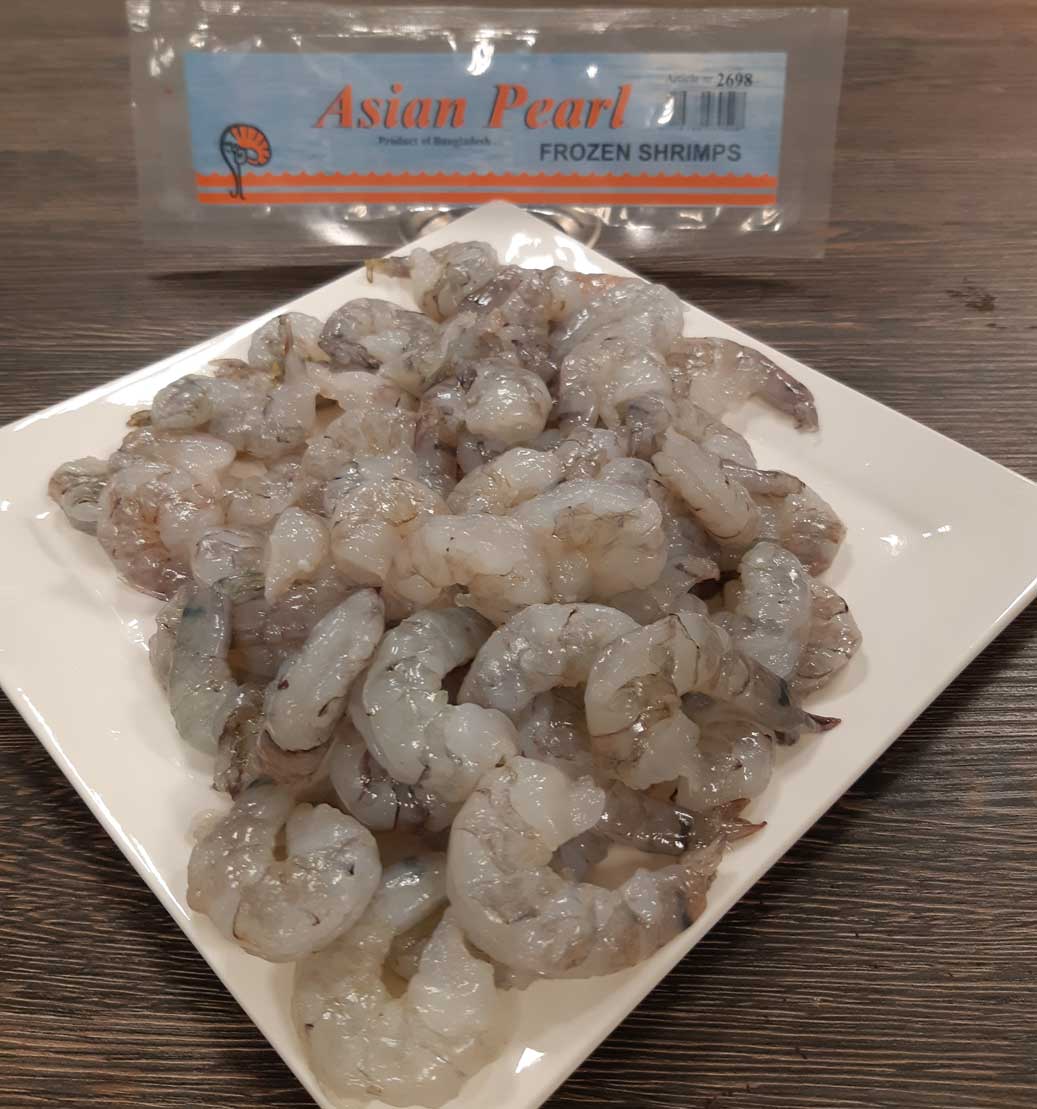Hey seafood lovers! Today I’m excited to share everything you need to know about one of my favorite types of shrimp – the magnificent black tiger shrimp. As someone who’s been cooking and writing about seafood for years, I can tell you these impressive crustaceans are truly something special.
What Exactly Are Black Tiger Shrimp?
Black tiger shrimp (Penaeus monodon) are large, tasty shrimp that naturally live in the Indo-Pacific region. We often call them by different names like:
- Giant tiger prawns
- Asian tiger shrimp
- Black tiger prawns
These big boys are pretty easy to spot thanks to their
- Distinctive dark stripes/bands on their shell
- Impressive size (females can grow up to 13 inches!)
- Slightly sweet, firm meat
Size & Appearance
Let me break down the typical sizes you’ll find:
Females:
- Length: 25-30 cm (10-12 inches)
- Weight: 200-320g (7-11 oz)
Males:
- Length: 20-25 cm (8-10 inches)
- Weight: 100-170g (3.5-6 oz)
Their looks are pretty striking – they’ve got these cool alternating red and white bands across their bodies. The legs and swimmerets (those little fin-like things) are brownish with reddish fringe.
Where Do They Come From?
These shrimp are native to
- Eastern coast of Africa
- Arabian Peninsula
- Southeast Asia
- Pacific Ocean
- Northern Australia
But here’s the thing – while you can still find wild-caught black tigers, most of what we eat today comes from farms. They’re actually the second most farmed shrimp species globally, right after whiteleg shrimp.
Why Are They So Popular?
I gotta tell ya. there’s a bunch of reasons why these shrimp are such a hit
- Amazing Texture: They’ve got this firm, meaty texture that holds up great during cooking
- Sweet Flavor: Their natural sweetness makes them perfect for all sorts of dishes
- Versatility: You can cook ’em any way you want – grill, fry, steam, you name it!
- Size Impact: Their large size makes them perfect for impressive presentations
Nutritional Benefits
For all you health-conscious folks out there, black tiger shrimp are pretty darn good for you:
- High in lean protein
- Rich in omega-3 fatty acids
- Good source of selenium and iodine
- Relatively low in calories
Cooking Tips & Storage
How to Pick Fresh Shrimp:
- Look for firm, plump texture
- Should have mild, slightly salty smell
- Avoid any that smell like ammonia
- Clear (not sunken) eyes if head-on
- No black spots or discoloration
Storage Tips:
- Fresh: Keep in fridge, use within 2-3 days
- Frozen: Store at 0°F or below
- Cooked: Refrigerate in airtight container for up to 3 days
Cooking Methods:
- Grilling: Perfect for their firm texture
- Sautéing: Quick and easy
- Steaming: Great for maintaining moisture
- Frying: Creates amazing crispy texture
- Poaching: Gentle cooking preserves flavor
Pro tip: These guys cook FAST – usually just 2-5 minutes depending on size and method. When they turn pink and opaque, they’re done!
Sustainability Concerns
I gotta be real with you – there are some environmental concerns with black tiger shrimp farming:
- Impact on mangrove forests
- Water pollution issues
- Disease problems in farming
But don’t worry! You can still enjoy them responsibly by:
- Looking for ASC (Aquaculture Stewardship Council) certification
- Choosing MSC-certified wild-caught options when available
- Supporting farms with sustainable practices
Common Uses in Different Cuisines
These versatile shrimp show up in dishes worldwide:
- Asian stir-fries
- Mediterranean pasta dishes
- Grilled skewers
- Seafood curry
- Classic shrimp cocktails
- Tempura
- Paella
Buying Guide
When shopping for black tiger shrimp, here’s what to look for:
Size Categories (count per pound):
- U/15 (Under 15 pieces)
- 16/20
- 21/25
- 26/30
For most home cooking, I’d recommend the 16/20 or 21/25 size – they’re perfect for most recipes!
Final Thoughts
Black tiger shrimp are truly one of the seafood world’s rock stars. Their impressive size, sweet taste, and versatility make them worth seeking out for your next seafood feast. While they might cost a bit more than smaller shrimp varieties, their meaty texture and fantastic flavor make them worth every penny.
Remember to keep sustainability in mind when purchasing, and don’t forget – these big boys cook fast! Whether you’re grilling them for a summer BBQ or adding them to your favorite pasta dish, black tiger shrimp are sure to impress.
Have you tried cooking with black tiger shrimp? What’s your favorite way to prepare them? Drop a comment below – I’d love to hear your experiences and recipes!
Note: Always remember to properly clean and devein your shrimp before cooking, and if you have shellfish allergies, these definitely aren’t for you!

An example to clarify
Suppose that a bag of shrimps with a gross weight of 1 kg consists of 25% water. After defrosting, the bag of shrimps consists of 250 grams of water and 750 grams of net weight shrimps. The wholesaler is obliged to display this net weight on the packaging label of the shrimps.
Incorrect net weight
As long as the percentage of added water is not too high and the net weight is clearly stated on the label, it is not a problem. But this is where things often go wrong. Many shrimp wholesalers instruct local farmers to add extra water to the shrimps without stating it on the label.
Therefore it is possible that a bag of shrimps consists of 30% or even 35% water, but that the label states a net weight of 750 grams. In reality, the net weight is only 700 grams or even 650 grams. This obviously makes it possible to sell the shrimps at a lower price.
As the shrimps in supermarkets are frozen, adding water is an easy and cheap way to add weight to a shrimp and make it look bigger. After all, you will only see the difference when the shrimps are completely defrosted. And nobody is going to weigh their shrimps again after defrosting.
Incorrect size grading
Another form of predatory pricing on the Black Tiger price per kilogram (gross weight) is to sell a smaller size grade than what is stated on the label. A cheaper and smaller size shrimp is sold with the label of a larger grade size. By adding extra water, the frozen shrimp in the supermarket then appears larger.
It is, of course, illegal to operate in the above way, as you are buying fewer shrimps than the weight shown on the label. Yet it is still common practice at many fish wholesalers, and the authorities have yet to intervene. Perhaps this will become a higher priority in the coming years.
How can the selling prices of shrimp wholesalers differ so much?
This brings us to the question to which you, as an entrepreneur or buyer of a major retailer, would like an answer. How can the selling prices of shrimp wholesalers differ so much? The quality of a box of Black Tigers or Vannamei shrimps is always the same. Right? Wrong.
The competition between shrimp wholesalers is enormous due to the popularity of the product. For this reason, many fish wholesalers want to distinguish themselves with lower prices, which is all at the expense of quality. For example, farmers in Southeast Asia are instructed to add more and more water to the shrimps
Adding water to shrimps and other fish species is a common practice and is known as glazing.

Grilling & Tasting Costco’s Black Tiger Shrimp #shrimp #costco #recipe
FAQ
What is the difference between black tiger shrimp and regular shrimp?
Black tiger shrimp and regular (often Vannamei) shrimp differ in size, appearance, and flavor.
Are black tiger shrimp good to eat?
Yes, black tiger shrimp are generally considered good to eat. They are known for their large size, firm texture, and rich flavor, making them a popular choice for various culinary applications.
What do black tiger prawns taste like?
Unlike cold water shrimp, whose meat can be watery and sometimes taste bland, warm water Black Tiger shrimp have a distinctly bold, sweet, firm-textured meat that has earned them the honour of being called the ‘poor man’s lobster’.
